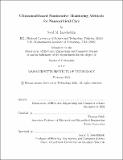Ultrasound-based Noninvasive Monitoring Methods for Neurocritical Care
Author(s)
Imaduddin, Syed M.
DownloadThesis PDF (18.33Mb)
Advisor
Heldt, Thomas
Terms of use
Metadata
Show full item recordAbstract
The human brain lacks internal energy deposits and instead relies on a steady uninterrupted supply of blood for its metabolic needs. Short-lived disruptions in cerebral blood supply can cause permanent damage. Likewise, mechanical stress on the brain can cause life-threatening and long-lasting damage to neural tissue. Existing neuromonitoring methods used for patients with severe head injury tend to be highly invasive and carry a risk of tissue damage and infection. To advance the field of clinical neuromonitoring, we developed a set of ultrasound-based noninvasive methods for real-time extra- and transcranial volumetric blood flow measurement and for embolus detection and embolic load quantification. The blood flow waveform measurements were also used to determine intracranial pressure (ICP), intracranial compliance (ICC), and cerebrovascular resistance (CVR) in a model-based, noninvasive, patient-specific, and interpretable fashion.
High frequencies (4-6 MHz) were used for extracranial insonation. Vessel diameters were estimated with B-mode images and were combined with color flow derived velocity measurements to yield the volumetric flow rate. B-mode derived diameter measurements had a bias of 0.2 mm and a root-mean-square error (RMSE) of 0.5 mm compared to manual annotations in a group of healthy adults. Lower frequency (1-2 MHz), lower spatial resolution insonation was necessary for transcranial application to overcome attenuation due to the skull. A spatial-resolution enhancement approach was therefore developed. The technique yielded a clinically acceptable flow estimation bias of 0.2 mL/min, and an RMSE of 22.3 mL/min over a 150 mL/min range of mean flows in phantom vessels with 2-6 mm diameters. In addition, a time-frequency approach was developed to separate closely-spaced emboli using single-channel, single-frequency insonation. The method decomposed 38% of candidate embolic signals into two or more embolic events that ultimately accounted for 69% of the overall embolic counts in pediatric patients undergoing extracorporeal membrane oxygenation or ventricular assist device therapy. Finally, tilt-table studies were carried out to validate the proposed cerebrovascular monitoring scheme. Our proposed system successfully tracked tilt-induced changes in ICP, ICC, and CVR.
The proposed techniques allow neuromonitoring across a wide spectrum of pathologies, patient age, and disease severity in a manner that has not previously been possible. The methods all rely on a common set of readily-available ultrasound imaging approaches, enabling a unified, ultrasound-based, single-probe, noninvasive neuromonitoring device with potential to revolutionize neuromonitoring worldwide.
Date issued
2022-02Department
Massachusetts Institute of Technology. Department of Electrical Engineering and Computer SciencePublisher
Massachusetts Institute of Technology